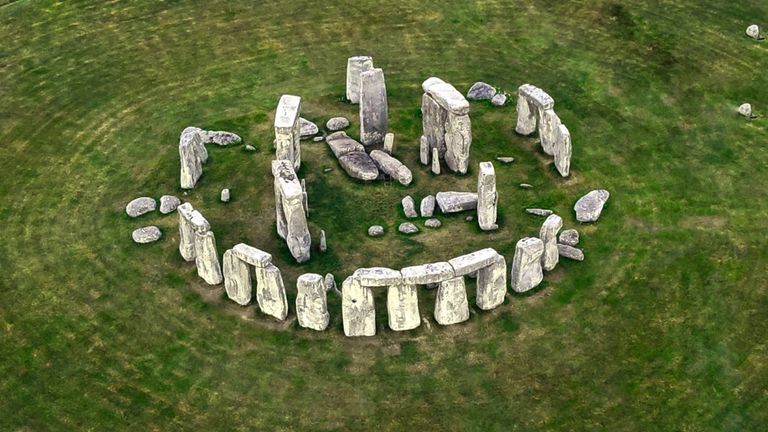Stonehenge discovery highlights 500-mile mystery - as central stone 'didn't come from Wales'
"Genuinely shocking" findings shed new light - and mystery - on the famous rocks and raise a key question: why was the central stone so important?
Wednesday 14 August 2024 12:54, UK
The Altar Stone at the centre of Stonehenge was brought 500 miles from northern Scotland - not Wales - as was previously thought, according to new research, adding to the mystery of the Neolithic site.
Geological fingerprinting has revealed the six-tonne stone almost certainly came from the Orcadian Basin, a rock deposit stretching north from Inverness up to the Orkney Islands.
"This is a genuinely shocking result," said co-researcher Dr Robert Ixer from University College London.
"The work prompts two important questions: why and exactly how was the Altar Stone transported from the very north of Scotland, a distance of more than 700km, to Stonehenge?"
Archaeologists do not know for sure when the Altar Stone arrived at the prehistoric monument in southern England, but it is thought to have been added during the second construction phase, sometime between 2620 and 2480 BCE.
The smaller stones - bluestones - that form the inner horseshoe and outer circle are known to have been quarried from the Preseli Hills of western Wales.
For the last century, the belief was the Altar Stone - made from a type of sandstone - was picked up en route to Stonehenge, perhaps near Swansea.
But in research that rewrites the textbooks, geologists used techniques from the mining industry to study mineral crystals within the sandstone.
Not only were there different types of minerals, but by studying traces of radioactive uranium within the crystals, the scientists had an atomic clock that could be used to establish their age.
That gave the stone a unique signature that matched with 95% certainty rock from northeast Scotland, according to results published in the journal Nature.
How was it transported?
Lead author Anthony Clarke, from Curtin's School of Earth and Planetary Sciences in Australia, said: "Our analysis found specific mineral grains in the Altar Stone are mostly between 1,000 to 2,000 million years old, while other minerals are around 450 million years old.
"This provides a distinct chemical fingerprint suggesting the stone came from rocks in the Orcadian Basin, Scotland."
The scientists are confident the Altar Stone was deliberately transported, not carried south by glaciers during an ice age.
One possibility is that it could have been brought on a raft, sailing down the coast of Britain. Mountains and dense forest would have made overland transport difficult.
But it is unclear exactly what was so special about the sandstone of northeast Scotland that made it worthwhile to transport to southern England.
Professor Chris Kirkland, a co-researcher from Curtin's University in Australia, said the findings had significant implications.
"Our discovery of the Altar Stone's origins highlights a significant level of societal coordination during the Neolithic period and helps paint a fascinating picture of prehistoric Britain," he said.
"Transporting such massive cargo overland from Scotland to southern England would have been extremely challenging, indicating a likely marine shipping route along the coast of Britain.
"This implies long-distance trade networks and a higher level of societal organisation than is widely understood to have existed during the Neolithic period in Britain."
Hunt still on
The earliest known major construction work on Stonehenge was around 3000 BCE. It enclosed an area with a circular ditch and bank and may have had upright timber posts.
A second construction phase around 2500 BCE led to the erection of the stones. The larger sarsen stones, weighing up to 30 tonnes, are believed to have been brought from the Marlborough Downs, 20 miles away.
The smaller bluestones weigh between two and five tonnes. Although they have varied geology, they come from the same area of western Wales.
Read more:
Stonehenge mystery 'solved'
Third arrest after Stonehenge spray
Be the first to get Breaking News
Install the Sky News app for free


Professor Richard Bevins, a co-researcher from Aberystwyth University, said the findings overturned what had been thought for the past century.
"We have succeeded in working out, if you like, the age and chemical fingerprints of perhaps one of the most famous of stones in the world-renowned ancient monument," he said.
"While we can now say that this iconic rock is Scottish and not Welsh, the hunt will still very much be on to pin down where exactly in the northeast of Scotland the Altar Stone came from."





